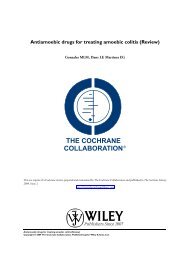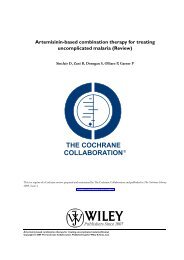Legislative smoking bans for reducing secondhand smoke exposure ...
Legislative smoking bans for reducing secondhand smoke exposure ...
Legislative smoking bans for reducing secondhand smoke exposure ...
You also want an ePaper? Increase the reach of your titles
YUMPU automatically turns print PDFs into web optimized ePapers that Google loves.
participants and outcomes <strong>for</strong> each study. No randomized controlled<br />
trials were identified. Twenty four studies included cohort<br />
follow up pre and post ban, in working populations, 18 studies<br />
comprised repeated cross-sectional measures mainly in general<br />
populations and 13 studies were quasi-experimental in design, in<br />
that they included a reference area. By tracking the same people<br />
over time, a longitudinal cohort is not affected by extraneous, between<br />
examination, confounders.<br />
The studies examined the effect of clean indoor air legislation<br />
implemented in countries, states and regional areas. The effect<br />
of the implementation of <strong>smoking</strong> ban legislation was considered<br />
in 13 different countries. Seventeen studies were in United States<br />
of America, eight in Scotland, five in Ireland, four in Italy, three<br />
each in Spain and Norway, two each in New Zealand, Canada and<br />
Finland, and one each in France, England, the Netherlands and<br />
Sweden.<br />
<strong>Legislative</strong> <strong>smoking</strong> <strong>bans</strong> vary in the extent to which they allow<br />
<strong>smoking</strong> or restrict it to designated areas. For this review, legislation<br />
which prohibits <strong>smoking</strong> in indoor workplaces, including<br />
bars and restaurants, is categorised as comprehensive, even though<br />
it may allow exemptions in particular settings e.g. prisons, or psychiatric<br />
and mental health settings. Legislation which allows designated<br />
<strong>smoking</strong> areas in indoor workplaces, including bars and<br />
restaurants, is categorised as a partial ban. Ten studies (Alcouffe<br />
1997; Bondy 2009; Brownson 1995; Fernández 2009; Galán<br />
2007; Gallus 2007; Heloma 2003; Khuder 2007; Jiménez-Ruiz<br />
2008; Verdonk-Kleinjan 2009) examined the effects of less restrictive<br />
legislation which did not prohibit <strong>smoking</strong> in bars and restaurants,<br />
and are categorised as partial ban studies. The remaining<br />
studies are categorised as comprehensive <strong>bans</strong>.<br />
Twenty-two studies were concerned with reduction of workplace<br />
<strong>exposure</strong>, nineteen of which were concerned with hospitality workers.<br />
Measures of passive <strong>exposure</strong> considered in these studies were<br />
self-reported <strong>exposure</strong> in general - at work or at home or in cars,<br />
biomarker verification, and prevailing air quality.<br />
Measures of active <strong>smoking</strong> considered were <strong>smoking</strong> prevalence<br />
rates, tobacco consumption and <strong>smoking</strong> cessation. Health outcome<br />
measures considered were respiratory and sensory symptomatology,<br />
cardiovascular events, including hospital admission<br />
rates <strong>for</strong> acute coronary syndrome or myocardial infarction.<br />
Risk of bias in included studies<br />
See Characteristics of included studies <strong>for</strong> a summary of the<br />
methodological characteristics.<br />
Study design<br />
The predominant type of study design was uncontrolled be<strong>for</strong>eand-after<br />
studies, either with cohort follow up or repeated crosssectional<br />
surveys. We found no randomized controlled trials where<br />
the primary intervention was a <strong>smoking</strong> ban. Thirteen quasi-experimental<br />
studies included a reference area with intervention and<br />
control conditions but non-randomly allocated, seven in a general<br />
or workplace setting (Allwright 2005; Biener 2007; Bondy 2009;<br />
Fernández 2009; Fong 2006; Hahn 2008; Hyland 2009), and six<br />
which were concerned with hospital admissions (Bartecchi 2006;<br />
Fichtenberg 2000; Khuder 2007; Pell 2008; Sargent 2004; Seo<br />
2007). All the remainder were uncontrolled studies with baseline<br />
measures and at least one or two post-ban assessments, including<br />
one study with three post-ban follow-up surveys (Farrelly 2005).<br />
Blinding<br />
Study investigators and participants could not be blinded since<br />
the introduction of legislation was public knowledge and was associated<br />
with a highly visible health behaviour . In one study the<br />
assessors measuring cotinine concentration were blinded as to the<br />
<strong>smoking</strong> status of the participants (Fernández 2009).<br />
Selection of participants<br />
Random sampling was used to select the participants in 16<br />
studies (Biener 2007; Braverman 2008; Brownson 1995; CDC<br />
2007; Eagan 2006; Fong 2006; Fowkes 2008; Gallus 2007;<br />
Gilpin 2002; Hahn 2008; Haw 2007; Hyland 2009; Jiménez-Ruiz<br />
2008; Lemstra 2008; Mullally 2009; Verdonk-Kleinjan 2009;).<br />
In five studies the method of selection was unclear or not reported<br />
(Akhtar 2007; Alcouffe 1997; Cesaroni 2008; Galán 2007;<br />
Palmersheim 2006). Eleven studies used a convenience sample<br />
(Abrams 2006; Bondy 2009; Ellingsen 2006; Farrelly 2005;<br />
Fernández 2009; Goodman 2007; Gotz 2008; Heloma 2003;<br />
Larsson 2008; Menzies 2006; Mulcahy 2005), with all but Abrams<br />
2006 and Heloma 2003 set in the hospitality sector. In six studies<br />
the bars were randomly selected <strong>for</strong> inclusion and their employees<br />
were invited either to participate (Eisner 1998; Fernando 2007;<br />
Hahn 2006; Pearson 2009; Semple 2007) or a mixture of random<br />
and convenience sampling was used (Allwright 2005) to select<br />
pubs in the intervention and control communities respectively.<br />
In Waa 2006, a random sample of participants was selected from<br />
the pre-ban cross-sectional surveys, and a convenience sample was<br />
used in the follow-up surveys. In one study, the assessors had to<br />
go through the entire list of randomized bars many times in order<br />
to achieve adequate sample size (Pearson 2009).<br />
Comparability of intervention and control<br />
communities at baseline<br />
Eight of the quasi-experimental studies described the demographic<br />
characteristics of participants in the control and intervention conditions<br />
at baseline (Allwright 2005; Bartecchi 2006; Biener 2007;<br />
Bondy 2009; Fernández 2009; Fong 2006; Hahn 2008; Seo 2007).<br />
<strong>Legislative</strong> <strong>smoking</strong> <strong>bans</strong> <strong>for</strong> <strong>reducing</strong> <strong>secondhand</strong> <strong>smoke</strong> <strong>exposure</strong>, <strong>smoking</strong> prevalence and tobacco consumption (Review)<br />
Copyright © 2010 The Cochrane Collaboration. Published by John Wiley & Sons, Ltd.<br />
6








